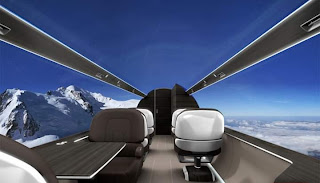Commercial air travel became popular in the 1930s. At that time, one of the major attractions of flying was the opportunity to see the vast sky and the landscape spread on the ground below the sky from outside the window.
American writer Daniel L. on the history of air travel. Rust wrote a book titled ‘Flying Across America’ in 2009. There, he mentioned, passengers still like to see rivers, deserts, farms or city skyscrapers from airplane windows.
Many of us like to see the outside world through the tiny airplane window.
American online publishing company ‘Quartz’ conducted a survey in 2014. It can be seen that more than half of the country’s residents prefer to sit next to the window when boarding an airplane.
Despite the popularity of windows among passengers, it’s surprising to learn that for decades, aircraft manufacturers have been considering replacing windows with video screens.
For example, in 2014, a UK-based organization called the Center for Process Innovation unveiled a design for a windowless aircraft. The design planned to replace the windows with thin and flexible high-definition video screens.
The outside view can be seen on the screens mounted continuously from one end to the other on both sides of the cabin. At the same time, it will be possible to show lighting or entertainment content there.
Advantages Of Not Having Windows In Airplanes
The aviation industry is responsible for a huge amount of carbon emissions every year. In 2019, commercial aviation accounted for more than 900 million metric tons of carbon emissions in one year alone. And 2.5 percent of total greenhouse gas emissions globally are caused by aviation alone.
Meanwhile, air traffic will grow by at least 4.5% over the next 20 years. Therefore, to deal with the impact of the aviation industry on the environment, various changes in the structure of the aircraft are being considered. One such change is the removal of windows from passenger aircraft.
Essentially, removing the windows from the aircraft would reduce its weight, thereby reducing fuel consumption. And if the fuel consumption is less, the amount of carbon emission will also be reduced.
If the weight of an aircraft can be reduced by 1%, the fuel consumption of the aircraft will be reduced by 0.75%. And if 1 tonne of fuel can be saved, approximately 3.15 tonnes less carbon dioxide will be emitted.
Engineers will try to find lighter, stronger and safer materials when building windowless aircraft. This will reduce production costs, while maintaining aircraft durability.
Engineers can work on more innovative aircraft designs when designing without windows. It will be possible to plan new and alternative ways in terms of the shape of the different parts of the aircraft, the arrangement of the seats or the comfort of the passengers.
However, even if the future aircraft does not have windows, the video captured by the camera installed outside the aircraft will be broadcast to the screen inside the aircraft. Passengers will get a wide view of the sky from different parts of the plane.
Various Initiatives To Create Virtual Windowed And Windowless Aircraft
In 2018, Dubai-based airline Emirates added some virtual windows to its Boeing 777 model aircraft. In that plane of Emirates, first class suite passengers are seated in the middle of the plane. First class passengers could not see the outside view.
However, first class passengers began to see images captured by cameras mounted outside the aircraft through a virtual window. Many of the passengers then reported that the view outside was clearer through the virtual window than through the real window.
Following this example of Emirates, it is possible that in the future other aircraft will also start the practice of installing display screens instead of windows.
In continuation of this, an American aircraft manufacturer is trying to make a completely windowless plane. Over the past few years, Boston-based private company Spike Aerospace has been working on an 18-passenger aircraft.
This plane named ‘Spike S-512’ will fly faster than sound and will have no windows. This fuel efficient aircraft will have many advanced technologies. Instead of windows, the plane will have two giant screens 20 feet or 6 meters long, which will be placed on either side of the passenger seats inside the plane.
Multiple ultra-high definition cameras will be mounted outside the aircraft to broadcast on these screens, which will capture ‘four k’ (4K) quality video. In addition to the outside view of the aircraft, it will be possible to show various entertainment programs or content on the screen.
Passengers can also use the screen next to them like a computer if they want. You can make power-point presentation or watch your favorite movie while sitting on the plane.
It is known that the vehicle design company ‘Technicon Design’ has developed a design for a windowless aircraft. The plane named ‘IXION’ will be replaced with high definition screens instead of windows. Apart from the two sides of the passenger seat, the screen will be installed on the roof. And on that screen it will be possible to see the outside view of the plane in 360 degree angle.
Cameras will be installed on two wings of this aircraft to capture the outside view.
Meanwhile, NASA and Lockheed Martin are working on developing a new type of supersonic aircraft that can travel faster than sound. And they plan to add a display screen instead of a window to the pilot’s seat of this plane.
It should be noted that in the 1970s, it was possible to make passenger supersonic aircraft. But while flying over any area, those planes generate high level of noise. This reason, along with other reasons, later led to a ban on supersonic aircraft.
The most commercially successful supersonic aircraft model was the Concorde, which could fly at twice the speed of sound. The aircraft carried passengers for the last time on November 26, 2003. No passenger commercial supersonic aircraft has flown since then.
To change this image, NASA is trying to build supersonic aircraft with new technology. That is why they have to bring innovative changes in the structure of the aircraft. One of the notable changes is the nose or front of the aircraft.
The front part of this aircraft under NASA research named ‘X-59’ (X-59) is very long, 38 feet. This huge part of the aircraft obstructs the pilot’s line of sight. To solve this problem, NASA decided to add a display screen to the pilot’s cockpit. On that screen it will be possible to monitor the movement of the aircraft from the view captured by the camera.
However, it is not yet known whether the aircraft will have a display screen for passengers.


